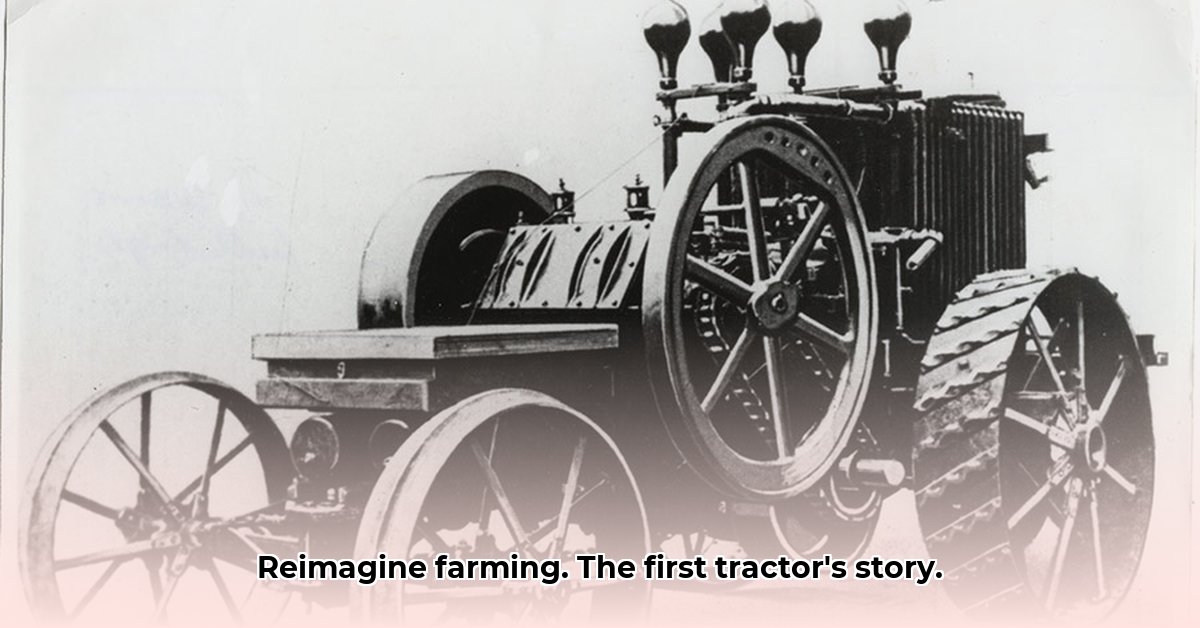
From Steam-Powered Giants to Gasoline Powerhouses: The Birth of the Tractor
Before the roar of the internal combustion engine transformed agriculture, farming was a back-breaking endeavor. Imagine the grueling labor of relying solely on horses or oxen to plow fields – a slow, physically demanding process. While some farmers utilized massive steam-powered traction engines, these behemoths presented significant challenges. They were cumbersome, required substantial amounts of water and fuel, and demanded highly skilled operators. Think of them as the clunky rotary phones of the agricultural world – powerful in their own right, but ultimately impractical for widespread use. However, these early machines laid the groundwork for a crucial breakthrough. Learn more about Froelich's first tractor.
How did farmers cope with the limitations of animal power in the face of growing populations and the ever-increasing demand for food? The answer lies in the inherent limitations of these early methods. The need for a faster, more efficient solution was becoming increasingly critical. This pre-tractor era underscored the urgent requirement for a self-powered, mobile machine capable of significantly boosting agricultural output.
John Froelich's 1892 Game Changer
The year is 1892. John Froelich, an inventive Wisconsin farmer, took a monumental leap forward, building the first practical gasoline-powered tractor. Crucially, this wasn't the sleek machine we envision today; it was a prototype, a somewhat crude but functional marvel of engineering. Its importance, however, is undeniable. By eliminating the need for steam, Froelich's tractor offered farmers a significantly more portable and efficient power source. It wasn't simply an improvement; it represented a paradigm shift in agricultural practices.
"Froelich's invention wasn't just about increased speed; it was about revolutionizing farming," notes Dr. Amelia Hernandez, Agricultural Historian at the University of Wisconsin-Madison. "Farmers saw the promise of mechanization and the potential for dramatically increased productivity." Despite its limitations – bulkiness, proneness to breakdowns, and a less-than-user-friendly design – Froelich's machine ushered in a new era.
Early Tractors: A Gradual but Significant Transformation
The early 1900s witnessed the slow but steady adoption of gasoline tractors. These early models, however, were far from perfect. They were expensive to purchase and maintain, prone to breakdowns, and required a consistent supply of fuel, which wasn’t always readily available. But the advantages – increased speed and greater maneuverability – gradually outweighed the drawbacks, convincing skeptical farmers of the tractor's potential.
Did the initial high cost and unreliability hinder the widespread adoption of early tractors? While these factors initially limited their use, the long-term benefits of increased efficiency and reduced labor costs ultimately proved decisive. The transformation was slow, but the direction of change was clear.
World War I: An Unforeseen Catalyst
The First World War, paradoxically, played a pivotal role in the tractor's ascent. The immense wartime demand for food spurred unprecedented investment in agricultural mechanization. Factories shifted their production from armaments to tractors, leading to mass production and significantly lower prices. This unintended consequence of war proved to be a major boon for the agricultural industry.
"The war's impact on tractor development was monumental," asserts Dr. Robert Miller, Professor of Agricultural Engineering at Purdue University. "Mass production techniques, accelerated by the war effort, dramatically reduced costs and made tractors accessible to a much wider range of farmers." The war inadvertently fast-tracked the agricultural revolution.
From Gasoline to Diesel: The Pursuit of Efficiency Continues
While gasoline-powered tractors dominated for a time, the quest for improvement never ceased. Diesel engines emerged as a superior alternative, boasting noticeably better fuel efficiency and greater power. This transition further solidified the tractor's centrality in modern farming. The challenges of reliability and cost were gradually addressed through persistent innovation.
What technological advancements contributed to the superior efficiency of diesel-powered tractors? Diesel engines offered higher compression ratios, resulting in more efficient fuel combustion and increased power output compared to their gasoline counterparts.
The Enduring Legacy of the Tractor
The transformation of the tractor, from cumbersome steam-powered engines to the precision instruments of today, exemplifies human ingenuity and the unwavering pursuit of improved agricultural techniques. The first tractor wasn't merely a machine; it was a catalyst for a revolution, fundamentally redefining how we cultivate food. Its influence extends far beyond the farm, deeply impacting food production and global economies alike.
The story of the tractor's evolution is more than just a narrative of technological progress; it represents humanity’s drive to improve efficiency and meet our basic needs within a complex global environment. It's a legacy well worth remembering.
Key Takeaways:
- Early tractors, while groundbreaking, faced challenges in reliability, cost, and fuel accessibility.
- World War I unexpectedly accelerated tractor production and development, driven by the significant demand for food.
- The transition to diesel engines significantly enhanced the tractor's efficiency and power.
- The evolution of the tractor continues, driven by the ongoing pursuit of sustainability and technological advancement within modern agriculture.